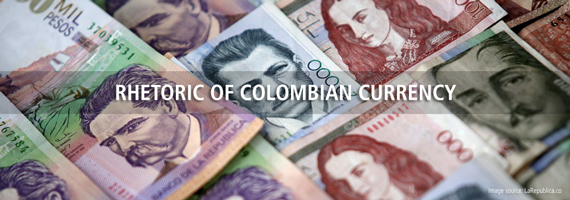Susceptibility to foreign shocks would be an adequate phrase to describe the Colombian peso's behavior against the U.S. dollar over the past months. Colombia's currency has what is described as a floating system, in which the value fluctuates according to the demand and supply of the market. This allows prices to regulate against different economical and financial events and changes in interest rates and yields. These movements are unpredictable by nature, and although there are measures to mitigate strong fluctuations, the truth is that being an emerging economy puts Colombia in the crosshair -- either good or bad -- for investors, shifting its economic landscape and conditions.
It is as though the currency had some sort of rhetoric, a way to serve as a mean of informing or persuading about the economical stability of the country. The exchange rate reflects meaningful events on the economy and oscillates accordingly. One could ask: how is the economy shaped by the perception of its currency? Or rather, does our exchange rate illustrate a general overview of the economy? How does this relate to the movement of capital and what effects does it have, but more importantly, what challenges arise from this perspective?
The central bank in Colombia intervenes the currency market through a U.S. dollar purchase program, in which it acquires nearly 18 million USD a day, in order to devalue the local currency. This devaluation creates beneficial conditions for Colombian exports and leads to a more competitive local market. Most productive sectors in the economy demand from the government the sustainability of a favorable exchange rate, and when this isn't the case, subsidies are claimed. The government, of course, cannot set the rate as they wish, since it fluctuates freely with the U.S. dollar. This refers to what is known in economic literature as the impossible trinity, which states that it is impossible for a central bank to have the following policies at the same time: fixed exchange rate, free capital movement, and an independent monetary policy. Colombia pursues an independent monetary policy -- the ability to set interest rates -- and free capital flow -- handling of foreign currency reserves -- therefore having a floating exchange rate system. Under this scenario, the central bank can only hope for their measures to gradually take effect in the medium term and smoothen the behavior of the exchange rate. Their actions do not have an immediate effect, and the possibility of an external shock modifying circumstances is always present.
The local currency had reached stable levels at the end of 2013, among with low figures for inflation and rising foreign direct investment. The dollar purchase program was doing its job correctly. But the market didn't foresee a major financial shock coming. The financial services firm JPMorgan decided to increase the percentage of Colombian public debt titles -- known as TES -- in its investment indexes, sparking a rally of nearly 2 billion USD into the financial system, almost instantly -- and considerably -- revaluing the Colombian peso. Such volatility bears the following figures: Year 2013 closes at 1,926 COP per USD, rises to 2,054 in February 2014, and gradually declines to 1,935 in April, recording digits as low as 1,905 in May. Analysis indicate the effect will last for another three to four months, with a considerable amount of U.S. dollars yet to come, further revaluing the local currency in the short term. Now, renowned economists have stated these are unlikely and low frequency occurring events, but the possibility remains, nevertheless.
Why did Colombian public debt titles become more attractive? Standard & Poors has recently announced Colombia's local and foreign currency rating, the former at BBB+, and the latter at BBB. The country has also shown a solid economy with positive perspectives in the short and medium term. Even so, foreign direct investment has begun to slowly decrease in the present year, recording 5,290 MM USD for the first four months, nearly 3.7 percent less than the previous year. There might be an insight pointing to what is known as hot money: capital that flows regularly from low interest rate yielding countries to their higher counterparts, affecting the exchange rate if the sums are big enough. But the real problem lies in the permanence of this money, which usually migrates to the highest bidder regardless of the circumstances. So how is the economical landscape shifting and what role does Colombia play in it?
The increase in rates by the Federal Reserve will most likely attract capital back into the United States, which will result in a higher demand for US dollars, which in turn leads to a more devalued Colombian peso -against the USD- in the medium term. Worded simply, the economy will continue to show solid macroeconomic indicators, investment will most likely remain at its current levels -- maybe even slightly decrease -- and ultimately, the exchange rate will rise. This suggests stable foreign investment levels and favorable conditions for exports and the development of the industry. The challenge for the local government remains: to foster exports to an international market, aid in the comeback of the industry and focus its efforts in the development of infrastructure projects through out the country. The underlying issue lies in the competitiveness of the country, not on the exchange rate itself. It is undoubtedly a factor of major importance, but in no way a determinant to the success of the country's performance. Structural matters must be addressed, and circumstances are proving to be favorable for the execution of such.
Data retrieved from: Banco de la República (Colombia's Central Bank)

